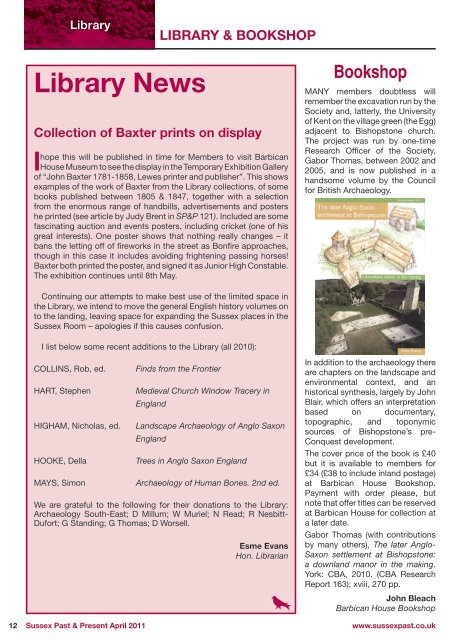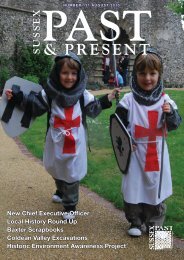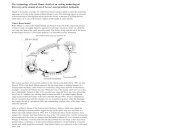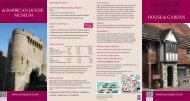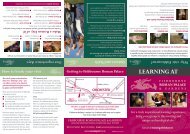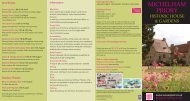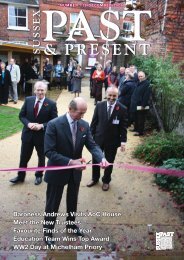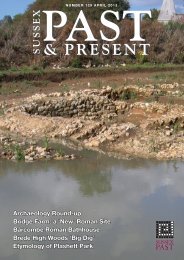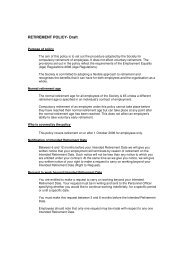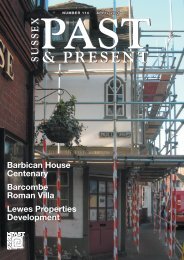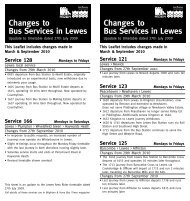April 2011 (issue 123) - The Sussex Archaeological Society
April 2011 (issue 123) - The Sussex Archaeological Society
April 2011 (issue 123) - The Sussex Archaeological Society
You also want an ePaper? Increase the reach of your titles
YUMPU automatically turns print PDFs into web optimized ePapers that Google loves.
Library<br />
LIBRARY & BOOKSHOP<br />
FIREBACKS<br />
Books<br />
Library News<br />
Collection of Baxter prints on display<br />
hope this will be published in time for Members to visit Barbican<br />
I House Museum to see the display in the Temporary Exhibition Gallery<br />
of “John Baxter 1781-1858, Lewes printer and publisher”. This shows<br />
examples of the work of Baxter from the Library collections, of some<br />
books published between 1805 & 1847, together with a selection<br />
from the enormous range of handbills, advertisements and posters<br />
he printed (see article by Judy Brent in SP&P 121). Included are some<br />
fascinating auction and events posters, including cricket (one of his<br />
great interests). One poster shows that nothing really changes – it<br />
bans the letting off of fireworks in the street as Bonfire approaches,<br />
though in this case it includes avoiding frightening passing horses!<br />
Baxter both printed the poster, and signed it as Junior High Constable.<br />
<strong>The</strong> exhibition continues until 8th May.<br />
Continuing our attempts to make best use of the limited space in<br />
the Library, we intend to move the general English history volumes on<br />
to the landing, leaving space for expanding the <strong>Sussex</strong> places in the<br />
<strong>Sussex</strong> Room – apologies if this causes confusion.<br />
I list below some recent additions to the Library (all 2010):<br />
COLLINS, Rob, ed.<br />
HART, Stephen<br />
HIGHAM, Nicholas, ed.<br />
HOOKE, Della<br />
MAYS, Simon<br />
Finds from the Frontier<br />
Medieval Church Window Tracery in<br />
England<br />
Landscape Archaeology of Anglo Saxon<br />
England<br />
Trees in Anglo Saxon England<br />
Archaeology of Human Bones. 2nd ed.<br />
We are grateful to the following for their donations to the Library:<br />
Archaeology South-East; D Millum; W Muriel; N Read; R Nesbitt-<br />
Dufort; G Standing; G Thomas; D Worsell.<br />
Esme Evans<br />
Hon. Librarian<br />
Bookshop<br />
MANY members doubtless will<br />
remember the excavation run by the<br />
<strong>Society</strong> and, latterly, the University<br />
of Kent on the village green (the Egg)<br />
adjacent to Bishopstone church.<br />
<strong>The</strong> project was run by one-time<br />
Research Officer of the <strong>Society</strong>,<br />
Gabor Thomas, between 2002 and<br />
2005, and is now published in a<br />
handsome volume by the Council<br />
for British Archaeology.<br />
In addition to the archaeology there<br />
are chapters on the landscape and<br />
environmental context, and an<br />
historical synthesis, largely by John<br />
Blair, which offers an interpretation<br />
based on documentary,<br />
topographic, and toponymic<br />
sources of Bishopstone’s pre-<br />
Conquest development.<br />
<strong>The</strong> cover price of the book is £40<br />
but it is available to members for<br />
£34 (£38 to include inland postage)<br />
at Barbican House Bookshop.<br />
Payment with order please, but<br />
note that offer titles can be reserved<br />
at Barbican House for collection at<br />
a later date.<br />
Gabor Thomas (with contributions<br />
by many others), <strong>The</strong> later Anglo-<br />
Saxon settlement at Bishopstone:<br />
a downland manor in the making.<br />
York: CBA, 2010. (CBA Research<br />
Report 163); xviii, 270 pp.<br />
John Bleach<br />
Barbican House Bookshop<br />
British Cast-Iron<br />
Firebacks of the 16 th<br />
to mid 18 th Centuries<br />
FIREBACKS are among the most<br />
common surviving artefacts of the<br />
early modern iron industry. Whereas<br />
most cast-iron ordnance was either<br />
abandoned on the battlefield or<br />
re-melted, the latter fate shared<br />
by railings and other architectural<br />
ironwork, firebacks have fared much<br />
better. <strong>The</strong>y tended to be left in situ,<br />
at once both decorative and useful,<br />
Plate 269. Mid to late 17th century fireback bearing<br />
a phoenix rising from the flames. Anne of Cleves<br />
House Museum.<br />
as long as open fires remained<br />
the only form of domestic heating,<br />
and often afterwards. Some have<br />
been removed to museums, but<br />
thousands remain at the back of<br />
hearths in great and not-so-great<br />
houses all over the country. Survival<br />
is especially good in the South East,<br />
where the Wealden furnaces were<br />
major producers of castings.<br />
It is surprising to find how little<br />
has been written about firebacks.<br />
<strong>The</strong>re are, apparently, no early<br />
20 th -century collectors’ books, nor<br />
have historians of the iron industry,<br />
except H.R. Schubert and writers<br />
on the Weald, given them much<br />
attention. <strong>The</strong>y do not feature greatly<br />
in books on country houses and<br />
their contents. This new study by<br />
Jeremy Hodgkinson can, therefore,<br />
be unreservedly welcomed as the<br />
first large-scale monograph on<br />
the subject. It is a first-class piece<br />
of work in all respects, not least<br />
the high standard of design and<br />
printing, and the reasonable price.<br />
Plate 203. Wealden fireback of the early 17th<br />
century; this combination of the English crown and<br />
French arms is often copied and may relate to the<br />
marriage of Charles 1 and Princess Henrietta Maria<br />
of France in 1625. Michelham Priory.<br />
After explaining what a fireback is<br />
and discussing related artefacts<br />
such as graveslabs, the first chapter<br />
describes how they were made and<br />
(as far as is known) how they were<br />
marketed. <strong>The</strong> bulk of the book is<br />
a detailed catalogue of decoration<br />
on firebacks, progressing from<br />
designs created from individual<br />
stamps to backs cast from<br />
complete patterns. Hodgkinson<br />
shows how the basic fireback could<br />
be extended lengthways or with<br />
base panels, and suggests how<br />
purchasers today can distinguish<br />
an original from a copy. Virtually all<br />
the pieces discussed are illustrated<br />
with exceptionally well reproduced<br />
black and white photographs,<br />
printed to a constant scale. This is in<br />
itself a considerable achievement,<br />
since firebacks are often difficult<br />
of access and require skill to light<br />
successfully. Full details of each<br />
piece are given in an appendix,<br />
leaving the text to adopt a more<br />
discursive approach. This explores<br />
the iconography of firebacks in a<br />
highly original way. Hodgkinson<br />
has identified the sources for<br />
some of the best known designs,<br />
and analyses the royal and private<br />
heraldry found on firebacks. He has<br />
also located and illustrates several<br />
wooden patterns.<br />
Plate 245. Late 16th century or early 17th century<br />
fireback, probably cast in the Weald, portraying two<br />
protestant martyrs during the Marian persecution.<br />
Anne of Cleves House Museum.<br />
Most of the examples are drawn<br />
from the Weald, the major producing<br />
area and (outside London) the home<br />
of the major museum collections.<br />
To build on this study it would<br />
be useful to have gazetteers of<br />
firebacks in each county. It would<br />
also be good to know more about<br />
the fireback trade: how many were<br />
produced, were they made to<br />
order or for stock, and how much<br />
did they cost. <strong>The</strong>se would not be<br />
easy questions to answer but a full<br />
national catalogue would be a useful<br />
starting point. In the meantime,<br />
Jeremy Hodgkinson has done a<br />
first-class job in bringing together<br />
so much material and presenting<br />
his findings in such a scholarly and<br />
attractive volume.<br />
Philip Riden<br />
University of Nottingham<br />
By Jeremy Hodgkinson.<br />
Hodgersbooks, 2010. Paperback,<br />
278 pp., 342 illustrations, £24.99.<br />
ISBN 978-0-9566726-0-5.<br />
12 <strong>Sussex</strong> Past & Present <strong>April</strong> <strong>2011</strong><br />
www.sussexpast.co.uk www.romansinsussex.co.uk <strong>Sussex</strong> Past & Present <strong>April</strong> <strong>2011</strong> 13


